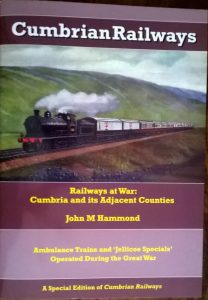Railways at War: Cumbria and its Adjacent Counties, Ambulance Trains and ‘Jellicoe Specials’ Operated During the Great War. Cumbrian Railways Association, 2019. Quarto, 64 pages, illustrated, laminated card cover. £8. Post and packing £2.50. Overseas please ask for a quote.
“The book covers two very important aspects of the Great War, and without them victory would have been in doubt.
Written by CRA member John M Hammond, in the first part, the operation of specially built ambulance trains is described, with a particular reference to their use in the counties of Cumberland, Westmorland and north Lancashire. A network of these trains was set up to collect wounded soldiers arriving at our home ports to distribute them to the numerous specialist hospitals set up to treat the growing number of injured personnel.
In part two, John describes how high quality coal was transported to the north of Scotland to supply the ships of the Grand Fleet. These trains were called ‘Jellicoe Specials’ after the Admiral of the Fleet, John Rushworth Jellicoe and we learn how they were worked through the counties that now form the modern county of Cumbria.
Both stories record the valuable work done by the railways during the Great War, much of it never before covered at this level of detail. As you might expect, other railway companies operating both north and south of the border feature prominently in both parts.”

